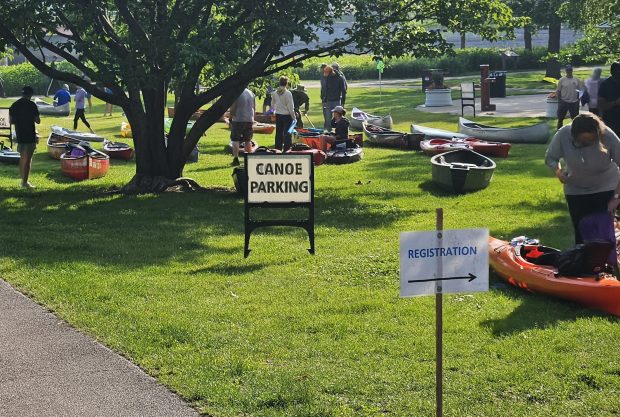Long-underway work to improve pedestrian safety and traffic flow in Naperville’s Westside neighborhood is set to finish by the end of this year, a city official said.
Improvements, which have been in the works for some six years, are in their final stages, according to city project manager Michael Prousa.
In 2018, the city received several reports of traffic concerns from residents in the Westside neighborhood, which is bounded by the BNSF Metra line on the north, Washington Street and downtown Naperville to the east and the west branch of the DuPage River to the south and west.
Complaints included motorists speeding and ignoring stop signs around the neighborhood, inconsistent or confusing signage, heavy volumes of vehicles and pedestrian safety, Prousa said.
The city hired Rosemont-based traffic engineering consultant Kenig, Lindgren, O’Hara, Aboona Inc. (KLOA) to conduct a traffic study in which it was tasked with gathering data and offering recommendations on addressing vehicle speeds and traffic volume and improving safety for pedestrians and cyclists going to and from neighborhood schools.
Final recommendations were presented to the Naperville City Council in early 2021. In February 2021, the council OK’d a myriad of small solutions to address concerns and city staff have been chugging away at implementing them since, Prousa said.
A bulk of the improvements focused on updating signage and striping throughout the Westside neighborhood. For instance, stop signs were removed and installed and shared lane markings and bike route signs added.
Other larger projects included changing part of Eagle Street in front of Naper Elementary into a one-way to revamp circulation around the school; extending out the curb on Jefferson Avenue at West Street and on Mill Street at Douglas Avenue; and installing a sidewalk on the north side of Douglas Avenue from West Street to just past Laird Street.
Changes were prioritized based on cost and ease of implementation, Prousa said. A lot of the smaller work, he said, was tied up by summer 2021 whereas the larger upgrades are just getting completed this year.
The overall cost for the work has been about $240,000, according to Prousa. A significant portion of that expense stemmed from the curb extensions put in at Jefferson/West and Mill/Douglas, which were installed in early August, Prousa said.
Curb extensions are a traffic calming measure that essentially involve bulbing a curb out into an intersection. The idea is that by crowding the road with more curb, vehicles slow down while pedestrians are more visible and don’t have to spend as much time on the road with less distance to cross, Prousa said.
Extensions were recommended at Jefferson/West because of its proximity to Centennial Beach and how often that section of road is filled with pedestrians, he said. Similarly, Mill/Douglas was ideal for extensions because it’s a heavily used school crossing with Naper Elementary and Washington Junior High schools nearby, Prousa added.
Now complete, the roadway at Jefferson and West was reduced from 33 feet to 22 feet in both directions of traffic to accommodate 5.5 feet of curb extensions on either side. The road at Mill and Douglas was reduced from 31.4 feet to 22 feet in both directions of traffic to accommodate 4.7 feet of curb extensions on either side.
The only improvement the city has yet to finish is the added sidewalk planned for Douglas. Physical work aside, there are a few educational tools that the city is hoping to put together about safe transportation that have yet to go live on its website. Both projects are expected to wrap up by the end of this year, Prousa said.
As work starts to wind down, the city will start collecting follow-up data on the effectiveness of improvements. In coming weeks, there will be a follow-up study to look at how curb extensions are faring and to gauge if they are having the intended effect, he said.
Generally, the improvements are welcomed, Westside resident Veronica Porter said.
“I’m definitely for the improvements in the area. …It’s heavily (trafficked). There’s the elementary school, there’s the junior high,” Porter, a third generation resident of Naperville, said in a call Monday. “We get a lot of traffic, especially now with Washington being down. …So I think it’s always good to be improving.”
The changes near Naper Elementary, which is across the street from Porter’s house, have been particularly noticeable, she said. She also spoke to the curb extensions installed last month, noting that she thinks “having a traffic calmer just makes people realize” that they are driving in a residential area.
“You’re coming into my home, so to speak, and it’s good for you to kind of slow down,” she said. “It’s not a freeway, it’s a neighborhood.”
Kathy Benson — former president of the Westside Home Owners Association (WHOA), which was behind the initial push for improvements in the neighborhood — likewise spoke to upgrades Monday. Echoing Porter, she said changes by Naper Elementary especially have been “very well-received” but that she expects the new sidewalk planned along Douglas to yield a mixed response from residents.
Benson, however, didn’t speak from an official WHOA position as the association is no longer active, she said.
During the pandemic, WHOA went on a “hiatus,” she said. Benson is hoping to start it up again, she said, if there’s enough neighborhood interest.



